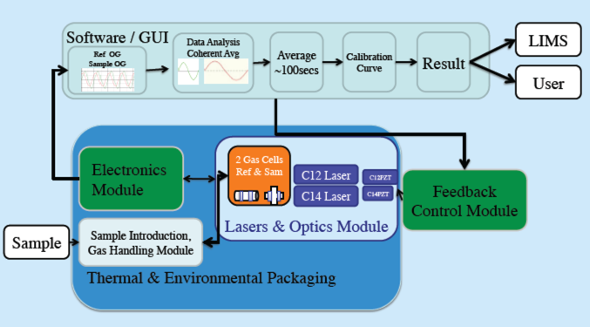
Block Diagram of system

Invention Summary:
Current technologies for low specific activity radiocarbon analysis are currently limited in precision and accuracy by sample size requirements, background effects, long sample measurement times, and difficulty of use.
Researchers at Rutgers have developed an optogalvanic effect detection system for determining the radiocarbon content of carbon dioxide in an electrical discharge. This system uses fixed frequency lasers, proprietary electronic circuitry and analysis algorithms. The system is highly efficient, requiring samples of only 10 or more micrograms. It is modestly sized for bench top use, and provides similar results to laser ring-down spectroscopic analyzers that require much larger sample size. Samples can be introduced individually or sequentially and the system can be coupled to GC or HPLC fraction collectors. In addition to radiocarbon detection, the system can be configured for Carbon 13, Oxygen 18 or Oxygen 17 analysis, as well as for other trace element detection.
Advantages:
- Small sample size with improved accuracy and precision
- Novel benchtop operation
- Rapid and straightforward analysis of results
Market Applications:
- Pharmaceutical industry: Drug metabolism- organic tracer studies for Pharmakokinetic/ Toxicity in drug development, Microdosing studies
- Environmental monitoring of atmosphere, soil, oceans, nuclear power plants
- Carbon accounting- fossil fuels vs biogenic carbon detection
- Laser stabilization systems
Intellectual Property & Development Status: US Patent issued US- 11,525,804 and pending. Peer reviewed article in the Journal of Applied Physics. Available for licensing and/or research collaboration. Please contact marketingbd@research.rutgers.edu